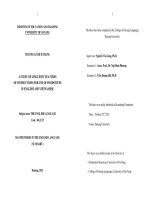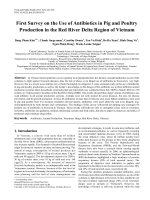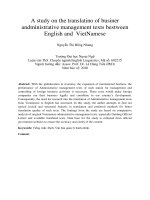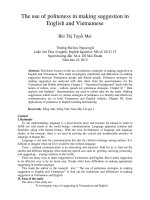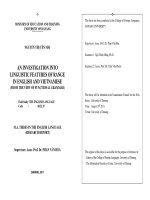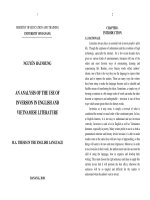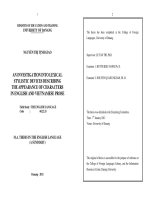The use of politeness in making suggestion in English and Vietnamese
Bạn đang xem bản rút gọn của tài liệu. Xem và tải ngay bản đầy đủ của tài liệu tại đây (207.22 KB, 3 trang )
The use of politeness in making suggestion in
English and Vietnamese
Bùi Thị Tuyết Mai
Trường Đại học Ngoại ngữ
Luận văn Thạc sĩ ngành: English liguistics; Mã số: 60 22 15
Người hướng dẫn: M.A. Đỗ Mai Thanh
Năm bảo vệ: 2012
Abstract. This thesis focuses on the use of politeness strategies in making suggestion in
English and Vietnamese. This study investigates similarities and differences in making
suggestion between Vietnamese people and British people. Politeness strategies for
making suggestion are analyzed with data taken from the questionnaires for the
Vietnamese and British informants. Chapter I: “ theoretical background” deals with the
notion of culture, cross – culture, speech act, politeness strategies. Chapter II: “ Data
analysis and findings”: Questionnaires are used to collect data for the study. Making
suggestions which resorts to various strategies of politeness is a flexibly and effectively
communicative act in both Vietnamese and English cultures. Chapter III: Some
applications of politeness in English teaching and learning
Keywords. Tiếng Anh; Tiếng Việt; Giao tiếp; Lời gợi ý
Content
I. Rationale
To our understanding, language is a great heaven prize and treasure for human in order to
fulfill our vital needs as the social beings: communication. Language appeared, remains and
flourishes along with human history. With the seen development of language and language
studies at the moment, there is no need in proving the crucial and irreplaceable position of
language in human life.
Language is not only for communication but also for cultural exchange among nations. It is
difficult to imagine what our lives would be like without language.
Cross – cultural communication is an interesting and attractive field for us to find out the
similar and different language when studying speech acts such as: greeting, advising, promising,
and suggesting… among countries in the world.
There are many ways to make suggestion in Vietnamese and English. But to make suggestion
in an effective way is by no mean easy. People often have difficulties in making appropriate
suggesting in another language.
This leads the author to the research into “ The use of politeness strategies in making
suggestion in English and Vietnamese” to find out the similarities and differences in making
suggestion in Vietnamese and English
II. Aims of the study.
The aims of the study are:
- To investigate ways of suggesting in Vietnamese and English
- To compare and contrast the use of politeness strategies in suggesting in given
Vietnamese and English suggesting situations.
- To contribute to raising language teachers’ and students’ awareness of cross –
cultural differences in the speech act of suggesting.
III. Scope of the study
In all aspects of politeness, the study only deals with verbal aspects, in the light of the
politeness theory by Brown and Levinson.
The paper is aimed to investigate the English – Vietnamese cross – cultural interaction in
making suggestion in both languages English and Vietnamese. The data analysis is mainly taken
in to account of interviews with informants to examine politeness strategies based on collected
situations of the act of suggestions. The data were collected by conducting surveys with
questionnaires. In addition, the data from the informants are also utilized in the study.
IV. Research question
1. How are politeness strategies manifested in suggestion in English and Vietnamese?
2. What are the implications for teaching and applying the speech act suggesting in cross
cultural communication in Hai Phong private university.
V. Method of the study
The following methods are resorted to:
- Conducting survey (with questionnaires as a data collection instrument)
- Consulting the supervisor
- Reading relevant publications
- Conducting personal observations
VI. Organization of the study
The study will be organized into the following structure::
Part I: INTRODUCTION outlines the rationale, the methodology, the aims, the scope, the
significance and the organization of the study.
Part II: DEVELOPMENT
Chapter 1 LITERATURE REVIEW reviews the theoretical issues. It briefly present and
discusses the theory of cross – cultural communication and summaries of politeness strategies,
summaries of works on suggestion.
Chapter 2 DATA ANALYSIS presents and discusses similarities and differences in using
politeness strategies in making suggestion in English and Vietnamese.
Chapter 3 Some applications politeness strategies in teaching English
Part III: CONCLUSION
Summary of major findings and suggestion for further study
Suggestion for further study
References
In English
Austin,J.L. (1962). How to do things with words. New York: Oxford University Press.
Bach, K. and Harnish, R. (1984). Linguistic Communication and Speech Acts. England: The MIT
Press.
Berko R. M. et. al, (1989). Communicating, Houghton Mifflin Comapany, Boston
Blum-Kulka, S. (1987). Indirectness and politeness in requests: Same or Different?. Journal of
Pragmatics, ii, 131-14-6.
Blum-Kulka, J. House, & G. Kasper (Eds.). (1989). Cross-Cultural Pragmatics: Requests and
Apologies. Norwood, New Jersey: Ablex Publishing Corperation.
Brown, P and Levinson, S. (1990). Politeness: Some Universals in Language Usage. Cambridge
University Press
Crystal, D. (1992). An Encyclopedic Dictionary of Language and Languages. England:
Blackwell.
Crystal, D. (1996). The Cambridge Encyclopedia of Language. USA: Cambridge University
Press.
Delahunty, G. P. and Garvey, J. J. (1994). Language, Grammar, and Communication. McGraw-
Hill. Ini.
Ellis, C. (1997). Culture Shock! Vietnam. Times Editions PTE Ltd
Green, G. M. (1989). Pragmatics and natural language understanding some English
Vietnamese Cross-cultural.
Gillham, B. (2000). Developing a questionnaire. Continuum. London and New York
Holliday, A. et. al. (2004), Intercultural Communication, Routledge
Hybels, S. et. al. , (1992), Communicating Effectively, McGraw-ill, Inc.
Jackson, H. and Stockwell, P. (1996). An Introduction to the Nature and Functions of Language.
UK: Stanley Thrones (Publisher), Ltd.
Kramsch, C. 1998), Language and Culture, Oxford: OUP
Lado, R, (1957). Linguistics across cultures. The University of Michigan Press
Lustig, M. W., et. al., (1996). Intercultural Competence. HarperCollins College Publishers
Yule,G. (1996). Pragmatics. Oxford. OUP
In Vietnamese
Nguyễn Hoà (2003). Phân tích diễn ngôn- Một số vấn đề lý luận và ph-ơng pháp. NXB Đại
học Quốc Gia Hà Nội.
Nguyn Vn (2004). Tìm hiểu mối liên hệ Ngôn ngữ-Văn hoá., Nhà xut bn i hc Quc
gia Hà Ni
Nguyễn (Văn) Quang (1999). Một số khác biệt giao tiếp lời nói Việt- Mỹ trong cách thức khen
và tiếp nhận lời khen. Luận án Tiến sĩ. ĐHKH-XHNV ĐHQG Hà Nội.
Nguyn Quang (2002). Giao tip và giao tip giao vn hoá, Nhà xut bn i hc Quc gia Hà
Ni
Nguyn Quang (2004). Mt s vn giao tip ni vn hoá văn giao vn hoá Nhà xut bn i hc
quc gia Hà Ni.
Nguyn Quang (2004). Cú điển dụng học Anh - Việt. Nhà xut bn Từ Điển Bách Khoa Hà
Ni.
Nguyễn Thiện Giáp (2002). Dụng học Việt ngữ. Nhà xuất bản Đại học Quốc Gia Hà Nội.


